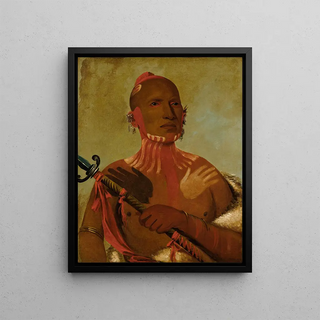Art print | The sturgeons WeSheet direct a fox warrior - George Catlin


View from behind

Frame (optional)
In the rich and complex universe of 19th-century American art, George Catlin's work stands out for its ability to capture the essence of indigenous cultures through vibrant portraits and scenes of life. "Les esturgeons WeSheet dirigent un guerrier renard" is an iconic piece that transcends the simple pictorial frame to offer an immersion into a world where nature and spirituality intertwine. This artwork, both poetic and narrative, invites the viewer to explore the traditions and beliefs of Native American peoples, while highlighting the deep connection that unites them with their environment.
Style and uniqueness of the work
Catlin's work is characterized by a unique style that combines realism and romanticism. In "Les esturgeons WeSheet dirigent un guerrier renard," the painter uses vivid colors and dynamic compositions to create an atmosphere that is both lively and contemplative. The figures are depicted with meticulous precision, each detail carefully considered to reflect not only physical appearance but also the soul of the characters. The sturgeons, symbols of strength and wisdom, are beautifully rendered, while the fox warrior, the central figure of the scene, embodies courage and bravery. This piece is more than a simple representation; it is a celebration of the cultural and spiritual identity of indigenous peoples, a tribute to their way of living in harmony with nature.
The artist and his influence
George Catlin, born in 1796, is often regarded as the first artist to dedicate his career to documenting Native American cultures. Traveling across the United States, he created numerous works that testify to the diversity and richness of indigenous traditions. His commitment to preserving these cultures, then threatened by colonial expansion, makes him an iconic figure in art history. Catlin does not merely paint; he tells stories, conveys emotions, and awakens a collective consciousness about the need to safeguard these cultural heritages. His influence endures today, inspiring many contemporary artists who explore themes of identity

Matte finish

View from behind

Frame (optional)
In the rich and complex universe of 19th-century American art, George Catlin's work stands out for its ability to capture the essence of indigenous cultures through vibrant portraits and scenes of life. "Les esturgeons WeSheet dirigent un guerrier renard" is an iconic piece that transcends the simple pictorial frame to offer an immersion into a world where nature and spirituality intertwine. This artwork, both poetic and narrative, invites the viewer to explore the traditions and beliefs of Native American peoples, while highlighting the deep connection that unites them with their environment.
Style and uniqueness of the work
Catlin's work is characterized by a unique style that combines realism and romanticism. In "Les esturgeons WeSheet dirigent un guerrier renard," the painter uses vivid colors and dynamic compositions to create an atmosphere that is both lively and contemplative. The figures are depicted with meticulous precision, each detail carefully considered to reflect not only physical appearance but also the soul of the characters. The sturgeons, symbols of strength and wisdom, are beautifully rendered, while the fox warrior, the central figure of the scene, embodies courage and bravery. This piece is more than a simple representation; it is a celebration of the cultural and spiritual identity of indigenous peoples, a tribute to their way of living in harmony with nature.
The artist and his influence
George Catlin, born in 1796, is often regarded as the first artist to dedicate his career to documenting Native American cultures. Traveling across the United States, he created numerous works that testify to the diversity and richness of indigenous traditions. His commitment to preserving these cultures, then threatened by colonial expansion, makes him an iconic figure in art history. Catlin does not merely paint; he tells stories, conveys emotions, and awakens a collective consciousness about the need to safeguard these cultural heritages. His influence endures today, inspiring many contemporary artists who explore themes of identity






